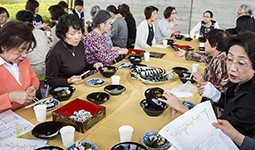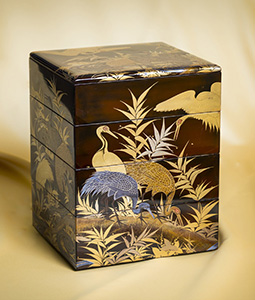Home > Highlighting JAPAN > Highlighting Japan November 2016 > The World of Japanese Cuisine
Highlighting JAPAN


Edo Banqueting Reborn
Tezen Museum in Shimane Prefecture showcases the haute cuisine of Edo times.
Honzen ryori, a traditional form of Japanese cuisine, originated in the highly refined banquets of the Heian period (794–1185), the golden age of aristocratic culture, and subsequently became established as a banquet style of the samurai class during the Muromachi period (1336–1573). During the Edo period (1603–1867) honzen ryori became popular among town and farming folk at weddings and other celebrations.
Honzen ryori begins with a dish called shiki-sankon. About six dishes are served in turn, including zoni soup, followed by the first course called ichi-no-zen, and then a second (ni-no-zen) and third (san-no-zen) served on trays called suzuri-buta. In the latter part of the Edo period, a style of honzen ryori that was simpler in terms of the types and numbers of dishes was served to commoners.
Various base ingredients are used in honzen ryori, including vegetables, fish, shellfish, tofu, mushrooms and seaweed. Japanese until the Edo period avoided eating animal meat such as beef and pork for religious reasons rooted in Buddhist teaching, but ingredients such as chicken, duck, quail and other fowl were used in cooking. Even today, vestiges of honzen ryori are seen in the san-san-ku-do at the wedding ceremony and in the zoni consumed at New Year’s dinners, but it is extremely rare in the Japan of today to see celebrations conducted based on the forms of honzen ryori typical of the Edo period.
Tezen Museum in the Taisha-cho district of Izumo City in Shimane Prefecture recreates the cuisine of the Edo period based on menus preserved at the museum. At a workshop which Tezen Museum held on October 17 at the Shimane Museum of Ancient Izumo in Izumo City, some of the honzen ryori recipes served at a wedding celebration of the Tezen family in 1857 were recreated.
At that time, more than a hundred dishes might be served at wedding celebrations conducted over a number of days. Given Izumo’s close proximity to the mountains and the sea, local people have made good use in their cooking of the diverse ingredients available in the region. These include fish and shellfish such as sea bream, which even today is consumed as a special dish on celebratory occasions, prized Izumo nori seaweed, freshwater fish, wild edible plants and mushrooms. Many dishes were prepared using large amounts of sugar, which was considered a delicacy during the Edo period.
The instructor of the workshop was Noboru Ando, who operates a Japanese restaurant in Izumo City. He led ten participants in recreating eleven dishes, including norimaki-zushi, or sushi wrapped in seaweed, and broiled sea bream. The recipes given in the historical materials do not describe the preparation methods, so preparing the dishes today requires some imagination. But condiments such as soy sauce, salt, sugar and vinegar were already available during the Edo period, so it is unlikely that the original taste was very much different.
After about two hours, workshop participants finished preparing the foods and arranged them on Japanese-style crockery handed down through the Tezen family. Four dishes were served in jubako stacked boxes, or lacquered wood boxes used to serve food on celebratory occasions such as the New Year. These dishes included kotake shiroae, prepared using kotake mushrooms, a rare food ingredient today, and Spinach ohitashi.
The two types of jubako box sets used in the workshop date from the late Edo period. One bears the image of a crane, the symbol of long life and prosperity, together with a flowing water pattern made using the maki-e technique. The other is lacquerware embossed with the crest of the Tezen family.
The umewan soup featured five ingredients including broiled sea bream chosen to harmonize with the five plum flower petals of the shikki lacquerware bowl’s design. The large plate used to serve the norimaki-zushi was a piece of brilliantly colored Imari ware of the late Edo period.
“Japanese people don’t normally use traditional Japanese crockery for daily meals these days,” says Anri Sasaki, curator of Tezen Museum, “but lacquerware is soft on the lips and has a warmth that plastic dishes lack. Also, one can most appreciate the beauty of Imari ware when food is carefully arranged on it. The workshop enables people to understand the richness of Edo-period cuisine and to experience the fun and thrill of enjoying it on original Japanese crockery.”
Participants in the workshop echoed these sentiments, saying that the lacquerware was unique in that the bowl was not hot to the touch even though the contents were. They also said it was nice to feel the spirit of service of the Tezen family in the food and dining ware.
Through workshops and museum displays, Tezen Museum plans to continue its efforts to popularize the culture of Izumo in the Edo period.
© 2009 Cabinet Office, Government of Japan









